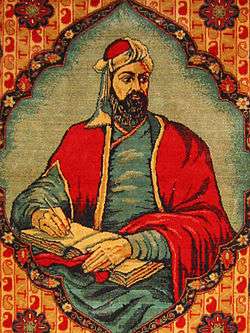Nizami Museum of Azerbaijani Literature
The National museum of Azerbaijan literature named after Nizami Ganjavi[1][2] (Azerbaijani: Nizami Gəncəvi adına Milli Azərbaycan ədəbiyyatı muzeyi) is a museum in Baku, established in 1939. It is located near the entrance of Icheri Sheher, not far from the Fountains Square. The museum is considered one of the greatest and richest treasuries of Azerbaijani culture.[3]
Nizami Gəncəvi adına Milli Azərbaycan ədəbiyyatı muzeyi | |
 | |
| Established | 1939 |
|---|---|
| Location | Azerbaijan, Baku, Istiglaliyyat Street 53 |
| Director | Rafael Baba oglu Huseynov |
| Public transit access | M 1 Icheri Sheher metro station |
| Website | nizamimuseum.az |
 |
| Part of a series on |
| Nizami Ganjavi |
|---|
| The Khamsa or Panj Ganj |
| Related topics |
| Monuments |
|
Nizami Mausoleum • Nizami Museum of Azerbaijani Literature • Nizami Gəncəvi (Baku Metro) • in Ganja • in Baku • in Beijing • in Chișinău • in Rome • in Saint Petersburg • in Tashkent |
Main goals
Collection, research and storage of scientific and other materials about Azerbaijani literature and culture, presentation of these materials on expositions and exhibitions is the main goal of the museum. There are carried out great scientific researches, published and written books and monographs.[4][5]
History of the museum


The building where the museum is located was built in 1850, as a one-storeyed caravanserais. In 1915, the building was given to “Metropol” hotel and the second storey was rebuilt. Then, in 1918-1920s, workers of the Cabinet of Ministers of the Azerbaijan Democratic Republic lived and worked there; in 1920-30s the labor union soviet of Azerbaijan was located there.[6][7]
On November 1, 1939, according to the order of the Council of People’s Commissars of the Azerbaijan SSR under the number № 4972, a memorial museum named after Nizami was created in this building in connection with the 800th anniversary of the Persian poet Nizami Ganjavi. The building was overhauled by the project of architects Sadikh Dadashov and Mikayil Huseynov, were placed sculptures in the façade and reconstructed two floors. Later, the memorial museum was changed to the Museum of Azerbaijani Literature. Interior of the museum was designed by Letif Kerimov. During World War II, when the 800th anniversary of the Persian poet Nizami Ganjavi was celebrated in Leningrad Blockade, the placement work of the museum’s exposition was continued. On May 14, 1945, the museum opened its doors to its visitors only after the victory in the Great Patriotic War, in spite of that, the museum was established in 1939.[8]
Twice, in 1959 and 1967, the museum was overhauled, expanded and upgraded. In 2001-2003, the museum was changed again.
In summer, 2005, after the visit of Ilham Aliyev-the President of Azerbaijan on December 30, 2004, were prepared new projects, on the basis of which the museum was overhauled and renewed.[9][10] The Cabinet of Ministers of Azerbaijan Republic assigned 13 million manats for that reason. Area of the exposition was expanded 2500 square meters, and the number of halls upgraded to 30 main and 10 auxiliary. If there were demonstrated only 1000 of 120000 exhibits till the reconstruction, after the reconstruction the number of them reached 25000.
The building
The total area of the museum is 2500 square meters, the 1409 meters of which consists of exposition and 173 square meters of fond. There are more than 3000 manuscripts, rare books, illustrations, portraits, sculptures, miniatures, memories of poets and other exhibits in 30 general and 10 auxiliary halls of the museum’s exposition. Part of the museum is a book shop.[11][12]
The sculptures of the eminent Azerbaijani poets and writers were placed on the façade of the museum on the following way: Muhammad Fuzuli (sculptor: F. Abdurrahmanov), Molla Panah Vagif (sculptor: S. Klyatskiy), Mirza Fatali Akhundov (sculptor: P.Sabsai), Khurshidbanu Natavan (sculptor: Y. Tripolskaya), Jalil Mammadguluzadeh (sculptor: N.Zakharov), and Jafar Jabbarly (sculptor: S. Klyatskiy). There are 120000 exemplars of the museum exhibits stored in the fond of the museum.[13]
Exhibits
A manuscript of Nizami’s Eskandar Nameh in Persian language, which was written in 1413, exemplar of a manuscript of Fuzuli’s “Bangu-Bade” (1569), “The Eastern poem about Pushkin’s decease” of Mirza Fatali Akhundov, personal autographs and other exhibits and expositions of great value are prides of the museum.
See also
- Literature of Azerbaijan
References
- "Official website of Azerbaijan National Academy of Sciences". science.az. Archived from the original on 2012-08-05.
- "Official website of the Museum". science.az.
- "Museum of Azerbaijan Literature named after Nizami Gandjavi". science.az.
- "Tarixi arayış". Azərbaycan Respublikası Mədəniyyət və Turizm Nazirliyi.
- "Nizami Museum".
- "Nizami Gəncəvi adına Milli Azərbaycan Ədəbiyyatı Muzeyinin ictimaiyyət üçün açılışı oldu".
- "Гостиница "Метрополь" - Музей aзербайджанской литературы им. Низами Гянджеви (Баку)".
- "В Национальном музее азербайджанской литературы имени Низами Гянджеви состоялась встреча с руководителями СМИ Азербайджана". APA. Archived from the original on 2012-06-13.
- "Nizami Gəncəvi adına Milli Azərbaycan Ədəbiyyatı Muzeyinin ictimaiyyət üçün açılışı oldu".
- "Nizami Museum".
- "Nizami Museum of Literature, Baku". virtual tourist.
- "Nizami Museum".
- "Музей Азербайджанской литературы им. Низами Гянджеви". CityLife.az. Archived from the original on 2012-04-25.
External links
| Wikimedia Commons has media related to Nizami Museum of Azerbaijan Literature. |
- Official website (in Azerbaijani, English, and Russian)